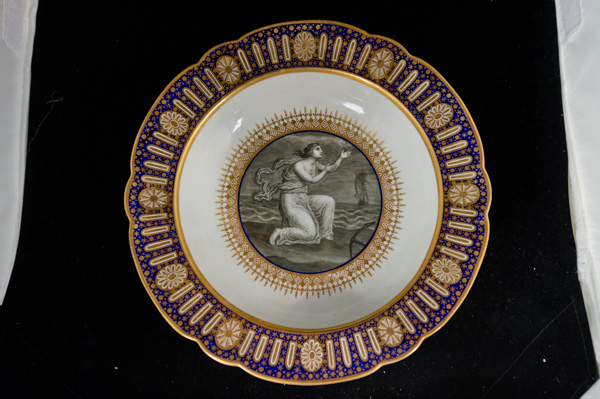Carol & Ryland Scott Porcelain Collection (for sale)
Part of the original collection by Cleo M. & George Ryland Scott


P139 - WORCESTER SOUP PLATE FROM THE “HOPE SERVICE”
Circa 1792, blue crowned script Flight and open crescent mark, painted by John Pennington
Painted en grisaille with a central cartouche of a figure allegorical of Hope at the water's edge, the underglaze-blue border gilt with paterae, stars and dots beneath a shaped gilt rim
10 in. (25.4) diameter
PROVENANCE
H.R.H. William Henry, Duke of Clarence, later H.M. King William IV, thence by descent to: Lord Frederick Fitz Clarence. William George, 18th Earl Erroll. Charles, 20th Earl of Erroll, sale Christie's 11th May 1893, lots 104-165.
LITERATURE
Cleo M. and G. Ryland Scott Jr., Antique Porcelain Digest, Newport, England, 1961, p. 198, plate 163, fig. 585.
EXHIBITION
On display in the Scott-Allen Collection at The High Museum of Art, Atlanta, Georgia from 1976 until 1996
On display in the “George Ryland Scott Collection” in The Memphis Brooks Museum of Art from June 1955 until May 1960.
NOTES BY CLEO M. AND G. RYLAND SCOTT, JR IN THE LATE 1950’S
This famous service was ordered from the Worcester factory by George III and his queen for the Duke of Clarence, a brother of the King and an Admiral in the English Navy. The workmanship on this service is outstanding. It was a mark of approval that the factory was permitted for the first time to use the crown as a mark. The blue is radiant and the gold unexcelled. The dinner service had probably five hundred pieces. None of it was in the hands of collectors until J. P. Morgan secured some examples for his collection. After his death they were sold. This piece was purchased from Marshall Field in Chicago. The painting is by John Pennington. It represents “Hope”, in many different poses. The scene is of a ship and an anchor and stars make up the design. The mark is the word Flight with the crescent and a crown.
---------------
Commissioned by the Duke of Clarence, later William IV (1765-1830) in January 1790, the entire Hope Service, of which this is part, took a year to produce and cost *GBP*700. It proved to be decisive for the Worcester factory, helping to establish its reputation as a manufacturer under Royal patronage after what had been a difficult period. The commission was won in competition against Derby; the Duke selected the design from five samples provided by John Flight. Four of these were painted with figures en grisaille by John Pennington, of whom little is known; related to the family of Liverpool porcelain manufacturers of the same name, he had been employed at the Wedgeweed decorating workshops in London, prior to being taken on by John Flight to replace the recently departed and previously most important decorators, the Chamberlains. His early work is generally characterized by figure-painting in monochrome, this commission probably the high point of his career.
The later erroneous and romantic association of the service with Admiral Lord Nelson was perhaps prompted by the somewhat nautical appearance of the decoration, which, although ichnographically typical of late 18th Century representations of Hope, came to be viewed in the 19th Century as being portraits of Lady Hamilton. This association was then reinforced when at the Christie's sale of 1839 the service was proclaimed as being that which had belonged to Nelson, this information having been derived from Lord Frederick FitzClarence's will.
Webmaster - Ryland Scott
© 2013, Ryland Scott